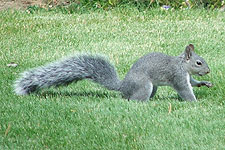Local Wildlife
Western Grey Squirrel

Scientific Name: Sciurus griseus
Addt'l Info: Univ. of Michigan
Western grey squirrels have a silver-grey coat and tail (the tail may also be streaked with black), large ears without tufts, and a white underside. They can grow up to two feet in length (including the tail) and sheds its fur once in the late spring and again in the early fall.
Home ranges are generally between one and 17 acres. They live in hollow trees or in nests they build called dreys. Dreys are made of sticks and lined and insulated with softer materials such as moss. Western grey squirrels can be found in all wooded areas of Sunriver between dawn and dusk. While they can be seen in trees, they spend most of their time on the ground foraging for food or burying excess seeds and nuts.
The main source of food for the western grey squirrel depends largely upon its local habitat. Those that live in coniferous forests feed primarily on the seeds of pinecones. Those that live in hardwood forests feed largely on nuts and acorns. The grey squirrel is also known to eat berries, fungus, bark, sap, and insects. It opens hard seeds and nuts using its incisors. Feeding may occur on the ground as well as in trees.
Breeding takes place once each year in the late spring. Most litters have three to five young. Squirrels, in general, have a very well developed sense of smell that allows them to locate nuts and seeds that have been buried. Western grey squirrels do not hibernate, but spend much less time outside during the winter months. When frightened, they make barking sounds while flicking their tails and stamping their feet.
